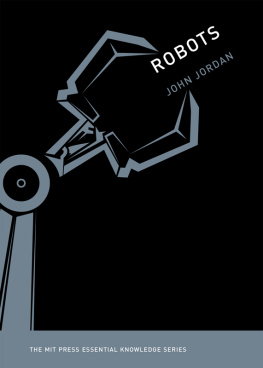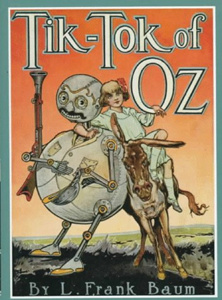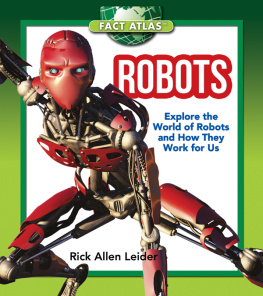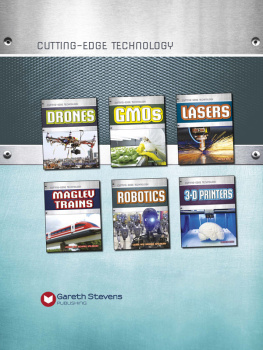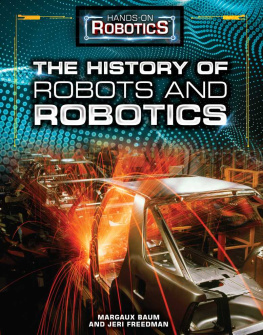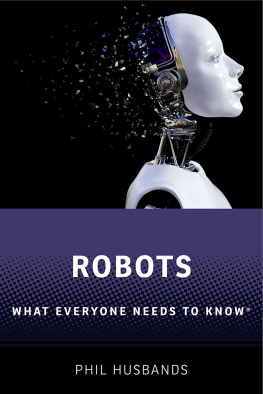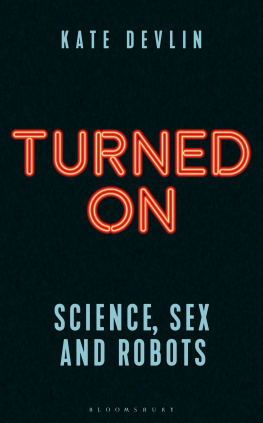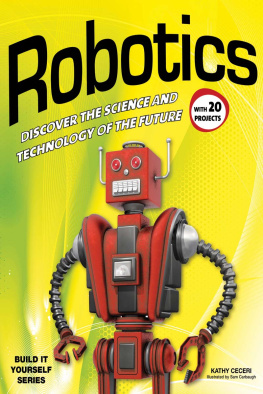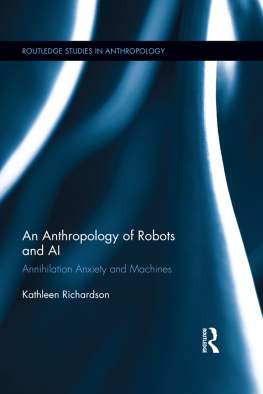The MIT Press Essential Knowledge Series
Auctions, Timothy P. Hubbard and Harry J. Paarsch
Understanding Beliefs, Nils J. Nilsson
Cloud Computing, Nayan Ruparelia
Computing: A Concise History, Paul E. Ceruzzi
The Conscious Mind, Zoltan L. Torey
Crowdsourcing, Daren C. Brabham
Free Will, Mark Balaguer
Information and the Modern Corporation, James W. Cortada
Intellectual Property Strategy, John Palfrey
The Internet of Things, Samuel Greengard
Memes in Digital Culture, Limor Shifman
Metadata, Jeffrey Pomerantz
MOOCs, Jonathan Haber
Neuroplasticity, Moheb Costandi
Open Access, Peter Suber
Paradox, Margaret Cuonzo
Robots, John Jordan
Self-Tracking, Gina Neff and Dawn Nafus
Waves, Frederic Raichlen
Robots
John Jordan
The MIT Press
Cambridge, Massachusetts
London, England
2016 Massachusetts Institute of Technology
All rights reserved. No part of this book may be reproduced in any form by any electronic or mechanical means (including photocopying, recording, or information storage and retrieval) without permission in writing from the publisher.
This book was set in Chaparral and DIN by Toppan Best-set Premedia Limited. Printed and bound in the United States of America.
Library of Congress Cataloging-in-Publication Data
Names: Jordan, John M. author.
Title: Robots / John Jordan.
Description: Cambridge, MA : MIT Press, [2016] | Series: The MIT Press essential knowledge series | Includes bibliographical references and index.
Identifiers: LCCN 2016008323 | ISBN 9780262529501 (pbk. : alk. paper)
eISBN 9780262335638
Subjects: LCSH: RoboticsPopular works. | RobotsSocial aspectsPopular works.
Classification: LCC TJ211.15 .J67 2016 | DDC 629.8/92dc23 LC record available at https://lccn.loc.gov/2016008323
ePub Version 1.0
Series Foreword
The MIT Press Essential Knowledge series offers accessible, concise, beautifully produced pocket-size books on topics of current interest. Written by leading thinkers, the books in this series deliver expert overviews of subjects that range from the cultural and the historical to the scientific and the technical.
In todays era of instant information gratification, we have ready access to opinions, rationalizations, and superficial descriptions. Much harder to come by is the foundational knowledge that informs a principled understanding of the world. Essential Knowledge books fill that need. Synthesizing specialized subject matter for nonspecialists and engaging critical topics through fundamentals, each of these compact volumes offers readers a point of access to complex ideas.
Bruce Tidor
Professor of Biological Engineering and Computer Science
Massachusetts Institute of Technology
Preface
Attempting to write a book about robots represents a leap of faith. The field is already broad and expanding further, and it moves too fast for a multiyear project to be at all current. Why, then, did I proceed?
The field of robotics is, I believe, entering a crucial stage. Technologies are good enough for mass commercialization, use by governments, and even to become invisible in their ubiquity. Robots will soon affect millions of peoples lives more directly and profoundly.
The technical choices made in robots design not only embody value judgments and aspirations; they often have ethical implications. Every roboticist I have met is smart, humane, and well spoken. Even so, I do not want a small population of scientists and engineers, working in isolation, to make all the decisions that can affect life, death, health, work and livelihood, class status, personal privacy, gender identity, the future of war, the shape of urban landscapes, and many other domains: they need help, and other perspectives.
This book seeks to widen the circle of individuals who have a say in what robots can and should do, look like, include, and leave out. I hope roboticists read the book, but the intended audience is the rest of us. Design choices made now may well be with us for decades, so now is the time to ask, and to assert, what good robots might look like. Because of the breadth and dynamism of the field, my narratives emphasis falls less on completeness and the latest developments, and more on the enduring issues: what are the persistent capabilities, contests, and trade-offs that will characterize robots and robotics?
Why do these issues matter? Many powerful scenarios involve humans and robots working in partnership rather than robots replacing humans, whether on a battlefield, in a hospital, on an assembly line, or in the rehabilitation, prosthetics, or aging processes. Rather than focusing on either-or debates over what constitutes a robot, we will be better served by seeing compu-mechanical augmentation of human traits on a continuum. By necessity, this implies both that robots and human beings will be living and working closely, changing the nature of the human condition in important ways, and that, rather than becoming only slaves or potentially overlords, robots will become humanitys partners. These impending changes make improving our theories, norms, and aspirations an urgent matter. This book, this leap of faith, is a small step in that direction.
Acknowledgments
This slim volume, five years in the making, was only possible with the help of many people, not all of whom can be named here.
Katherine A. Almeida, Kate Hensley, and especially Marie Lufkin Lee at the MIT Press have been consummate professionals, helping me, by turns, with advice, encouragement, constructive challenges, and superb execution. I count myself fortunate to have had the backing of such a capable team.
When Bob Bauer showed me the personal robot PR2 at Willow Garage back in 2011, that was the precise momenton a par with my first glimpse of the National Center for Supercomputing Applications (NCSA) Mosaic web browserthat I saw everything differently. Bob later introduced me to my key research interviewees, including Steve Cousins, Scott Hassan, James Kuffner, and Leila Takayama; without him, this book would never have happened, so my thanks are profound.
In addition to many anonymous readers from MIT Press who each improved this book, I can thank four readers by name. Steve Sawyer offered a generous, incisive critique of an earlier draft and dazzled me with the breadth of his suggestions. Kate Hoffman deepened my understanding of anime and science fiction, drawing on her vast trove of reading recollections and judgments. My longtime partner in tech analysis, John Parkinson, read multiple drafts and unfailingly helped me, whether by cracking macro framing problems or correcting imprecision in the details.
Finally, my onetime coauthor, David Hall, offered encouragement, critical reaction, and expert perspective every time I asked him, even though he had dozens of other irons in the fire. Death took him, suddenly and too soon, a month before this book went into production. I can only hope he would have been proud of the final result.
Introduction
Television and cinema have helped propagate powerful American stories of technology. The Star Wars franchise is in many ways an updated Western, using space as a frontier (though maybe not the final one) and light sabers as rifles. The impact of such iconsand possibly archetypesas Robocop, Blade Runners replicants, the brilliant, mannerly C-3PO, and Disneys Wall-E is wide and deep. Ask about throwbots, Atlas, Motoman, Kiva, Beam, or other real-life robots that are reinventing warfare, the industrial workplace, and human-robot collaboration, and most people have little sense of what real robots do or look like. But everyone knows the Terminator, complete with Austrian accent.
Next page
